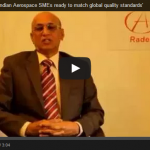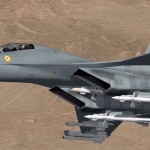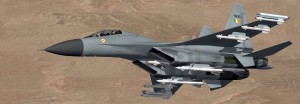The much-awaited changes to India’s Defence Procurement Procedure (DPP) were announced last month. This was in line with the promise made by Defence Minister Manohar Parrikar, after he took over the reins of Ministry of Defence in November 2014. The new look DPP, set to take shape in the next two months, gives major impetus to the Narendra Modi government’s flagship Make in India mission. It has some inspiring elements to boost Indian private companies to undertake research and development in the aerospace and defence (A&D) sector.
One India elicited the views of some of the private A&D players to capture the mood of the industry, which has always felt that enough is not being done to win their hearts. Here are the excerpts from a series of interviews we did recently. Offset mechanism not working in interest of country G Raj Narayan, Managing Director of Radel Advanced Technology (P) Ltd, has been a visible voice in the last couple of years in various A&D forums. He says it was clear from the beginning that the offsets mechanism wasn’t working to the interests of India. “The insistence of the foreign OEMs to dilute the same on the pretext of ‘not finding capable Indian partners’ was only an indirect method of preventing any exposure to Indian companies on related technologies. The only way to improve our state of self-sufficiency is to develop R&D in-house and design from whatever technologies we are presently exposed to (LCA, Jaguar & Mirage), and then move upwards to higher levels indigenously,” says Raj. According to him, the raising of the offset applicability to acquisitions of Rs 2000 crore and above is irrelevant. “The higher preference to ‘indigenously designed, developed and manufactured’ items certainly makes more meaning than the vague ‘Make’ and ‘Make & Buy’ categories. This is a confirmation of the preference for Indian products which needs to be applauded. Further, the focus on enabling and empowering R&D as well as supporting MSMEs through funding is a huge step forward. Though this could still throw up problems in distinguishing between ‘mature and capable’ MSMEs and ‘raw’ MSMEs, proper processes could certainly be set up to ensure that the right company get the right amount of funding appropriate with its track record and status,” Raj added. Radel’s ongoing projects for various military programmes include, auto-selector bomb release system, speed switch, anti-collision lights, cockpit control unit and ground test rigs of various aircraft and helicopters. Introduction of IDDM a good move Puneet Kaura, MD and CEO, Samtel Avionics, says that the introduction of a new category — Indigenous Design Development Manufacturing (IDDM) – is a welcome move. “We welcome the move to introduce the IDDM category in the DPP as it will back companies like us who have proven competencies in indigenous design, development and manufacturing. Furthermore, the announcement of funding by the government for R&D purposes will help build a technology base in the country,” says Puneet, among the early players in the A&D sector. He said the growth of the Indian defence industry has been marred by delays. “The new DPP addresses this through a definitive step to cut down the delays in procurement by reducing the time lag between AoN (acceptance of necessity) and the tender or request for proposal (RFP),” says Puneet. Samtel through its joint venture with HAL, has been developing MFDs for Su-30 MKI within its facility in Greater Noida. The Samtel-HAL JV has already delivered 125 sets of MFDs for Su-30 MKIs. Will boost investments and better quality of products According to Rajeev Kaul, MD & Group CFO, Aequs, told One India that that take on LI policy in the new-look DPP is a positive step. “L1 policy is a bold move and it credits the capability of the bidder. This would encourage quality consciousness and boost investments in better quality products,” says Rajeev. Aequs has been supplying main landing gear shackle for the B787 programme. Aequs manufacturing facilities are located in Belagavi, Bengaluru, and Houston. Offset limit should be brought back to Rs 300 crore Col H.S. Shankar (Retd), CMD, Alpha Design Technologies Pvt Ltd, feels that increasing the offset applicability limit is a retrograde step and will deny Indian industry, particularly MSMEs, large chunk of their work content. “It is our view that offsets (with Rs 300 00 crore and above limit) was working satisfactorily (except for few glitches at MoD) and benefiting Indian Industries enormously. This will be a big blow to Indian industries. The limit should be reviewed and brought back to Rs 300 crore. He said the MSMEs/FICCI had listed many suggestions to the DPP Review Committee, but they were not accepted. “We wanted the ‘Make’ category to be split into two categories: ‘Make’ large industries with higher limits and ‘Make’ MSMEs with a limit of funding up to Rs 500 crore per project,” says Col Shankar. Commenting on the ‘strategic partners,’ the veteran A&D expert felt that it was a retrograde move of brining in ‘public sector mentality’ into private sector by reserving few big players in private sector. “This is a back door entry for big private sectors – something which Kelkar Committee had recommended as ‘Udyog Ratnas’ in 2016 and rejected and not implemented by successive governments,” says Col Shankar. MSME categorisation limits for A&D products must go up Naresh Palta, CEO (Aerospace), Maini Group, said the government funding of 90 per cent for indigenous R&D will spur domestic products and technologies. He also felt that ‘accepting offers in single tender cases’ would remove major hurdles for industries developing niche products. However, Palta felt that the DPP’s new avatar is silent on measures for SME segment. “We want the new policy to increase MSME categorisation limits up to Rs 150 crore for A&D projects specifically. Further taxation relief to Indian products vis-à-vis imports, for level playing. We are still unable to compete our products in the domestic requirements with imported ones due to higher duties and taxation incident,” says Palta.
The original article appeared on One India







